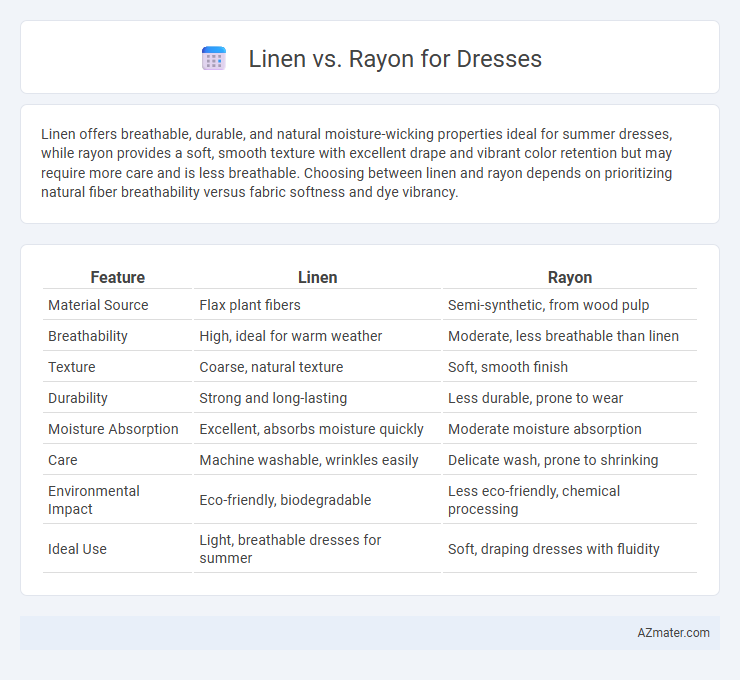Linen offers breathable, durable, and natural moisture-wicking properties ideal for summer dresses, while rayon provides a soft, smooth texture with excellent drape and vibrant color retention but may require more care and is less breathable. Choosing between linen and rayon depends on prioritizing natural fiber breathability versus fabric softness and dye vibrancy.
Table of Comparison
| Feature | Linen | Rayon |
|---|---|---|
| Material Source | Flax plant fibers | Semi-synthetic, from wood pulp |
| Breathability | High, ideal for warm weather | Moderate, less breathable than linen |
| Texture | Coarse, natural texture | Soft, smooth finish |
| Durability | Strong and long-lasting | Less durable, prone to wear |
| Moisture Absorption | Excellent, absorbs moisture quickly | Moderate moisture absorption |
| Care | Machine washable, wrinkles easily | Delicate wash, prone to shrinking |
| Environmental Impact | Eco-friendly, biodegradable | Less eco-friendly, chemical processing |
| Ideal Use | Light, breathable dresses for summer | Soft, draping dresses with fluidity |
Introduction to Linen and Rayon
Linen, derived from the flax plant, is a natural fiber renowned for its breathability, moisture-wicking properties, and durability, making it ideal for warm-weather dresses. Rayon, a semi-synthetic fiber produced from regenerated cellulose, offers a silky texture, excellent drape, and vibrant color retention commonly used in flowy, elegant dress styles. Both fibers provide unique comfort and aesthetic qualities, with linen excelling in ventilation and rayon favored for smoothness and versatility.
Key Differences Between Linen and Rayon
Linen, made from flax fibers, boasts superior breathability and moisture-wicking properties, making it ideal for warm weather dresses, while rayon, a semi-synthetic fiber derived from cellulose, offers a smoother texture and better drape with more vibrant color retention. Linen is naturally more durable and eco-friendly, but tends to wrinkle easily, whereas rayon feels silkier and softer but may require delicate care due to its lower tensile strength. The key differences lie in linen's natural fiber composition and texture versus rayon's engineered softness and vibrant finish, affecting dress suitability, care, and overall comfort.
Comfort and Breathability Comparison
Linen offers exceptional breathability due to its natural fibers, allowing maximum airflow and moisture absorption, making it ideal for hot and humid climates. Rayon, while softer and smoother, tends to retain more moisture and can feel heavier when worn for extended periods in warm weather. Both fabrics provide comfort, but linen excels in keeping the wearer cool and dry, whereas rayon emphasizes a silky texture with moderate breathability.
Durability and Longevity
Linen is known for its exceptional durability, made from strong flax fibers that resist wear and tear, making it ideal for long-lasting dresses. Rayon, a semi-synthetic fiber, tends to be less durable due to its cellulose-based composition, which can weaken with repeated washing and wear. Choosing linen over rayon ensures better longevity and sustained fabric integrity in dress materials.
Maintenance and Care Requirements
Linen dresses require gentle washing in cold water and air drying to prevent shrinking and maintain fabric durability, while rayon demands even more delicate handling, including hand washing or dry cleaning to avoid damage and color fading. Linen is naturally breathable and becomes softer over time, but its wrinkling tendency necessitates frequent ironing at medium heat, whereas rayon's smooth texture is prone to stretching and shrinking, requiring careful low-heat ironing or steaming. Proper maintenance of both fabrics extends the dress's lifespan, with linen offering easier care for casual use and rayon suited for formal wear under meticulous upkeep.
Environmental Impact and Sustainability
Linen is derived from flax plants, requiring less water and pesticides, making it a highly sustainable and eco-friendly fabric for dresses. Rayon production involves chemically intensive processes and heavy water use, often contributing to deforestation and pollution. Choosing linen over rayon significantly reduces environmental harm and supports sustainable fashion practices.
Aesthetic and Texture Analysis
Linen offers a natural, slightly coarse texture with a matte finish, creating an effortlessly elegant and breathable aesthetic ideal for summer dresses. Rayon provides a smooth, silky texture with a subtle sheen, lending dresses a luxurious drape and vibrant color vibrancy. Choosing between linen and rayon depends on whether you prefer a crisp, natural look or a soft, flowing silhouette.
Suitability for Various Dress Styles
Linen offers a breathable, textured fabric ideal for casual and summer dresses, providing natural wrinkles that enhance a relaxed, effortless look. Rayon, with its smooth, silky finish and excellent drape, suits more formal and flowy dress styles, creating a flattering silhouette for both day and evening wear. Choosing between linen and rayon depends on the desired aesthetic and occasion, balancing breathability and structure for dress design.
Cost and Affordability
Linen dresses typically have a higher price point due to the natural fiber's durability and breathability, making them an investment piece for warmer seasons. Rayon, being a semi-synthetic fabric, is more affordable and widely available, offering budget-friendly options without sacrificing softness and drape. Cost-conscious shoppers often prefer rayon for everyday wear, while linen appeals to those valuing long-term quality despite its higher initial expense.
Choosing the Best Fabric for Your Dress
Linen offers exceptional breathability and a natural texture, making it ideal for summer dresses that require durability and moisture-wicking properties. Rayon, with its smooth, silky feel and excellent drape, provides a more lightweight and flowy option suitable for elegant and comfortable dresses. When choosing the best fabric, consider linen for a casual, breathable style and rayon for a soft, luxurious finish that adapts well to formal designs.

Infographic: Linen vs Rayon for Dress
 azmater.com
azmater.com